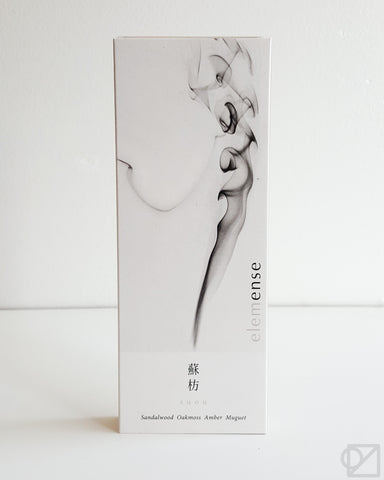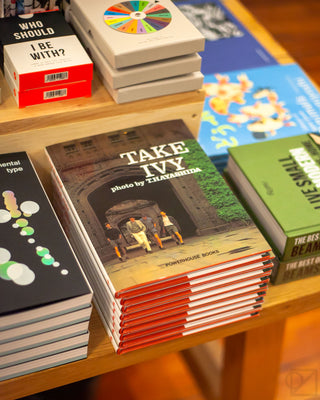Welcome to the second installment of our Burn This series, where we review our own selection of incense and other home fragrance goods. This time we're reviewing the five fragrances of Nippon Kodo's reimagined* Elemense line, "inspired by the 'Ten Virtues of Koh' blended with the ancient Chinese belief of the five elements."


The packaging is chic – information dense yet conveys the mood of burning incense at one's leisure. The incense inside is a unique wide core, all condensed powder, all-black stick, and comes with a heavy steel stand inside a wooden box. Very impressive, visually. But what do the five scents smell like?
To appreciate the fragrances, let's first turn our attention to the inspiration behind the line, the five Chinese elements and the 'Ten Virtues of Koh'. Elemense's own packaging describes the former, saying:
In ancient China, it was believed that every place, person, and object in the universe was made from these five elements: Moku, Ka, Do, Kon, and Sui.
That translates to Wood, Fire, Earth, Metal, and Water. Regarding the latter, it's worth knowing that koh「香」is the Japanese word for incense. The ten virtues of incense were apparently written down by a Zen practitioner of the Muromachi era, in the 16th century, and go like this:
It brings communication with the transcendent.
It purifies mind and body.
It removes uncleanliness.
It keeps one alert.
It can be a companion in the midst of solitude.
In the midst of busy affairs, it brings a moment of peace.
When it is plentiful, one never tires of it.
When there is little, still one is satisfied.
Age does not change its efficacy.
Used everyday, it does no harm.
With this in mind, we can now approach the individual fragrances and hopefully develop an appreciation for their layered nuances.

Nukubai
"Heals loneliness and brings a peace of mind from the warmth of the ash."
The fragrance description lists Sandalwood and Patchouli, followed by Tobacco and Vanilla. The stick itself smells both like earth and something soothing. Warm metal without the acrid iron tang. When flowers are just past their largest bloom of the season. "Ash" itself? Ash of what? After lighting the stick the "ash" smell becomes stronger and more present, but it's a fragrant wood ash smell, not unlike the embers of a hardwood fire almost extinguished. The fragrance evokes a liminal, mood-altering feeling. Very present. Feels well suited for grieving, meditating on transition, or processing change in general. The "healing" aspect is on point. I usually burn sensuous florals like rose or jasmine, or strong resins like copal when I wanted to activate a sense of self-care and healing for myself, so I am pleasantly surprised that the vanilla and sweet fragrant woods create a similar ambiance. This incense isn't powdery or floral nor overwhelmingly woody. "Ash" remains an apt description, and although confusing to read, once burned it all makes sense. Drawing out the ash – burn this – clear the way for what's next. Of the five Chinese elements, Nukubai represents Earth, and it's a warm feeling incense. It strikes me as good for any weather, but it has a notable presence and might be better suited for open windows or larger spaces. A good long burn. I really liked this one.
"Purifies the spirit and body by ridding negative thoughts."
Without reading the fragrance notes, the stick smells like powdery wood, like when you first walk into a woodshop but even more fragrant – sandalwood? I recognize a subtle sweetness but only after breathing with the stick under my nose while writing this. The fragrance description lists Agarwood, Cedarwood, Sandalwood, and Cypress. Oh, it's definitely all those four woods. I light the stick and sit back to enjoy beautiful twin spires of smoke on an overcast afternoon. I reread its emphasis on ridding negative thoughts and suddenly notice my own habitual scowl. So I relax my face and take a deep breath. This incense reminds me both of walking in dense forests after a rain and the warm feeling of a wood burning fire. I feel somewhere in between, calm and present. It represents Fire in the line-up, and I concur, it has that focused feeling of watching flame. The combination of woods is an excellent, unified blend more sophisticated than any one on its own (and leaps and bounds away from those overly crisp, rustic wood cabin-type fragrances typically marketed towards men). Kiyobi provides an overall relaxing atmosphere that masterfully utilizes the prized aspects of each respective wood involved. I think Kiyobi will be especially great on a chilly autumn day.

"Cultivates love for others by allowing one to appreciate plants and flowers that nature offers."
The stick reminds me of being a child and smelling an adult's perfume. Resin. Floral. A faint powder like walking by very pollen-dense, fragrant blooms. And is that oakmoss? Yes, now I imagine stumbling across a large damp log covered in a tapestry of moss. Then I reread the back of the box and raise my brow – wow, exactly that fragrance description: Sandalwood, Oakmoss, Amber, and Muguet (otherwise known as Lily of the Valley). Once lit, the fragrance shifts to give me a richer sense of earth, of mysterious forest, secret garden vibes. I can close my eyes and imagine myself in a very lush and ancient place, a night time atmosphere in a starlit garden. Suou represents Wood in the line-up, which is apt in my opinion given the ambiance it provides. I think if you enjoyed the discontinued KOJU line's MOEGI fragrance, you will take a strong liking to Suou.
"Awakens the sense of determination as tough as iron and kindles clarity as pristine as spring water."
Holding the stick under nose and concentrating on the smell as I breathe, I start to think of hot rocks in the sun, or in a sauna, and the sense of slow, steady reinvigoration that intense heat creates in the body. But it carries more of an astringent floral and aromatic freshness than simply hot rocks. Once lit, I think this might be my favorite. The fragrance description is Agarwood, Bergamot, Lavender, and Violet. The combination of the bright purple florals grounded against the wood and ash is excellent. As it burns in my living room and I go about my business, I feel more grounded. I muse on how purple things are special to me. And what is agarwood, anyway? A search online turns it up as a synonym for aloeswood and oud – two strong resinous woods that I'm regularly drawn to. Balancing the resin wood with astringent bergamot? Yes, please. Classic dandy violet with lavender? All very powerful protective and uplifting plants on their own. I really enjoy the in-betweenness – not too wood, floral, sweet, or powdery. Tetsukon represents Water in the line-up, which leads me to recall Bruce Lee's famous "be like water" mantra. This is a good incense for stilling the mind, practicing skills you want to eventually master, and getting things done.

"Set intentions as strong as rock."
Faint on the stick there is a tobacco sweetness mixed with a more pungent library bookshelf smell. The sweetness must be that agarwood/oud resin again. Sekishin represents Metal out of the 5 traditional Chinese elements, and its fragrance description is Agarwood, Ciste, Pink Pepper, and Everlasting. Pink Pepper, I recognize, and it balances the oud, differentiating it from the other fragrances in my opinion. Maybe this one smells most classically "incense" to me. It gives me a tranquil yet steadfast feeling, like the smell of walking into my old aikido dojo in the warmer months and breathing in the tatami mats, preparing my body for the training ahead. But there is a broader background ambiance at play. Ciste, it turns out, is labdanum, and Everlasting is the flower from which Helichrysum comes. Yes, I think, the ciste (shrub) is that old library smell, I think (a good thing). This incense uses resins of plants that are VERY hardy, growing in tough, sun-baked regions of Europe and Asia. Maybe that's why it smells so classic and strong. Hot sun resin – Sekishin might be awesome on an East Coast porch for replicating more sun-drenched climate feels of more barren lands.
Overall, the Elemense series is an evocative and well-considered line that I would say is worth the money for its complex and layered offerings. You get 40 slow-burning sticks that fragrance the room without an overpowering smokey odor or artificial smell. It starts as soon as you light and extinguish the stick, and lasts for some time afterwards in a closed room. Compared to scented candles, which require some time until the fragrance is warmed up and able to permeate the room (and which only gets stronger the longer it's lit), an incense like Elemense is great for quick mood setting according to your needs. The line also utilizes natural essential oils blended into compressed bamboo powder (hence the lack of a wood stick), which we believe provides a deeper scent and cleaner burn, desirable for smaller spaces or people who want to try home fragrance but are sensitive to overly strong ones. Or we could just say this is good incense, you might like it too, and leave it at that. =)
Curious to try? Shop Elemense and our other incense lines today.
Thanks for reading! We hope you found this review helpful.

 * Some of you may recall that we briefly sold a Nippon Kodo line also called Elemense, similarly based on the "5 elements of nature represent[ing] the wisdom of life." Its packaging clearly depicted earth, water, fire, air, and space themes, and offered strong and novel fragrances at a low price. However, as fate would have it, our customers much preferred our other incense lines utilizing natural essential oils, and so we let it sell out without restocking.
* Some of you may recall that we briefly sold a Nippon Kodo line also called Elemense, similarly based on the "5 elements of nature represent[ing] the wisdom of life." Its packaging clearly depicted earth, water, fire, air, and space themes, and offered strong and novel fragrances at a low price. However, as fate would have it, our customers much preferred our other incense lines utilizing natural essential oils, and so we let it sell out without restocking.





























Jörg
Best Incence we ve ever had!!!
Please let me know when you got the new.
Thanks a lot…
Mariam
Thorough article! I agree that Kiyobi seems like the perfect scent for fall.